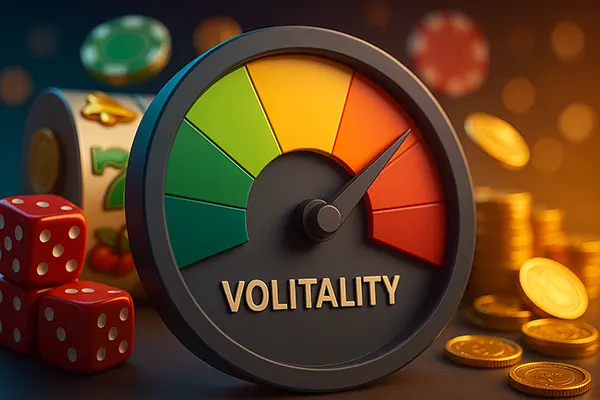
Game Volatility in Online Casino Play: How It Shapes Player Behaviour and Outcomes
Understanding game volatility has become an essential part of analysing how players approach online casino play in 2025. This concept influences expectations, bankroll planning, reaction to winning and losing streaks, and the long-term dynamics of different gameplay styles. By examining volatility in a practical and structured way, players can make more informed decisions and reduce the risk of relying on misleading assumptions. Below is a detailed review of how volatility functions and affects real-life behaviour patterns during online casino sessions.
What Volatility Means in Modern Online Gambling
Volatility describes how frequently a game pays out and how large those payouts generally are. Low-volatility titles produce regular returns that tend to be modest, while high-volatility games offer fewer results but with larger potential outcomes. In 2025, game providers continue to publish volatility ratings more transparently, allowing players to evaluate these characteristics before they start playing.
The choice of volatility affects session length. Low-volatility mechanics typically allow for longer sessions due to a slower decrease in the bankroll, while high-volatility options can deplete funds quickly when losing streaks occur. Players who understand these differences can match their expectations to the type of experience a particular game offers.
Volatility also affects emotional behaviour. Regular small wins can create a feeling of stability, while long gaps between payouts in high-volatility games can increase tension. This psychological influence shapes decision-making, especially when players adjust bet sizes or change strategies during a session.
How Volatility Ratings Are Calculated
Volatility is determined using mathematical modelling based on game simulations, symbol distributions and bonus-event frequency. Developers analyse millions of spins to estimate the depth and duration of potential losing streaks, as well as the probability of large payouts. Although these calculations rely on complex algorithms, the resulting volatility rating is presented to players in simplified form.
In 2025, several major studios have adopted standardised volatility scales. The most common format includes three categories: low, medium and high. Some developers further divide the spectrum into five or even seven levels. This helps players assess at a glance whether a game aligns with their preferences.
Despite these ratings, volatility does not predict exact outcomes. It indicates potential behaviour over extended play rather than guaranteeing specific results. Understanding this distinction helps players interpret volatility as guidance rather than a promise.
How Volatility Affects Player Behaviour During Sessions
Volatility strongly influences decisions related to bankroll management. Low-volatility users often choose smaller budgets spread over longer sessions, while high-volatility players may adopt larger starting bankrolls so they can withstand the long dry spells typical of such games. These approaches reflect different psychological responses to risk.
Winning patterns also affect behaviour. Low-volatility games encourage steady participation because players receive frequent feedback in the form of small wins. High-volatility mechanics, in contrast, create extended periods without payouts, and this can lead to quicker cash-out decisions or more aggressive betting depending on the individual’s tolerance for variance.
Another behavioural factor is how players evaluate “near misses” and features such as free spins or special symbols. High-volatility users may place greater emotional weight on triggering rare bonus rounds, while low-volatility players tend to focus on consistent base-game returns. These behavioural differences shape long-term engagement and personal risk strategies.
The Role of Expectations in Player Psychology
Expectations shape how players react to volatility. When a user understands that a high-volatility game can take considerable time to reveal its full potential, they are less likely to misinterpret natural losing streaks. Accurate expectations reduce frustration and help prevent impulsive decisions.
In low-volatility play, expectations revolve around stability rather than sudden change. Players value predictability and often use these titles to test new betting strategies. Because results arrive more steadily, individuals can track patterns and adjust their approach in real time.
Unrealistic expectations are one of the leading causes of poor decision-making. By aligning expectations with volatility level, players enhance the clarity of their gaming behaviour and reduce emotional swings that may lead to risky choices.

Why Volatility Matters for Long-Term Outcomes
Volatility affects long-term results because it determines the distribution of wins across extended play. While all licensed games maintain a fixed RTP percentage, volatility defines how this percentage unfolds. High-volatility titles may deliver most of their RTP through rare but substantial wins, whereas low-volatility games spread RTP through smaller, more frequent outcomes.
Players planning long-term strategies must account for variance in results. In high-volatility play, extended downturns are normal and do not indicate technical issues. In low-volatility scenarios, prolonged losses are less expected, and users may reassess their budget or strategy more quickly.
Understanding volatility also helps players choose games aligned with their personal goals. Some individuals prefer long, steady sessions, while others are motivated by the possibility of high-impact outcomes. Volatility provides a structured way to navigate these preferences.
Balancing Volatility With Bankroll Strategy
Effective bankroll planning is directly connected to volatility level. High-volatility games generally require larger reserves or smaller bet sizes to avoid rapid depletion of funds. Low-volatility players can maintain moderate stakes because the stability of results supports longer participation.
In 2025, responsible gaming tools offered by operators help users manage volatility-related risks. Features like loss limits, time reminders and spending trackers allow players to monitor how volatility affects their decisions. These tools provide additional safeguards during prolonged sessions.
Balancing volatility with a realistic budget helps players stay in control. When individuals understand how different volatility levels interact with betting patterns, they can maintain a more consistent and structured approach to gameplay.
